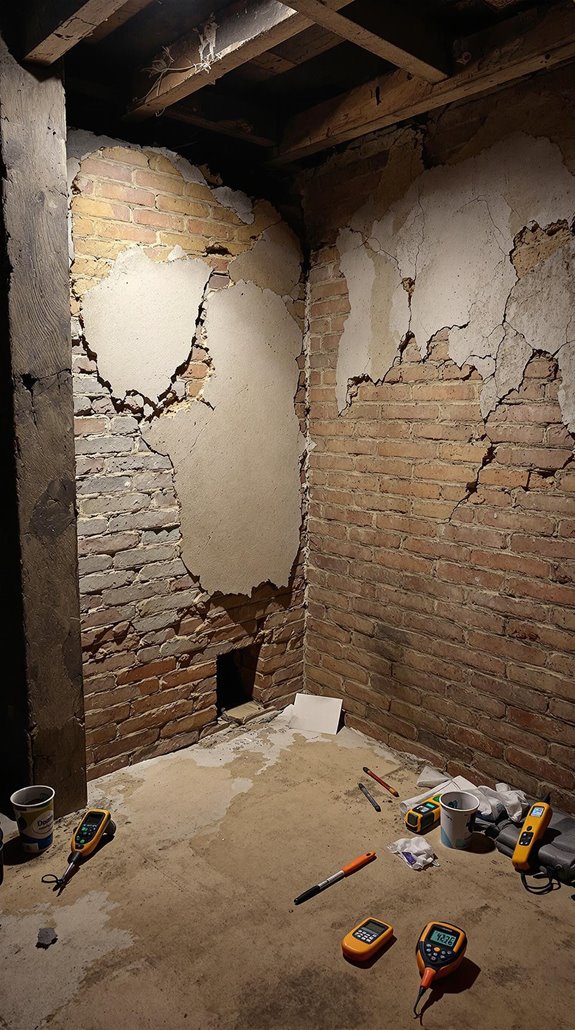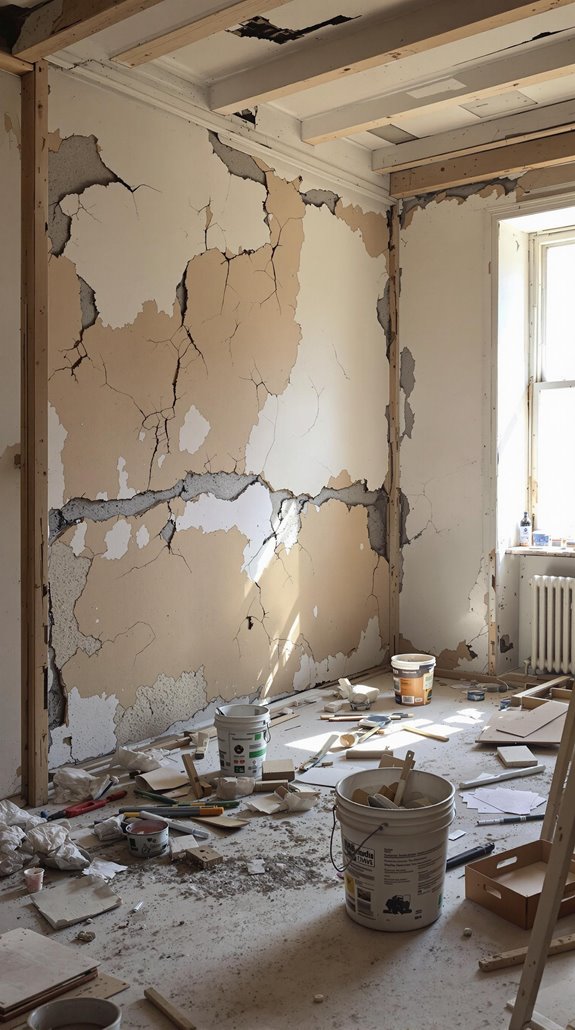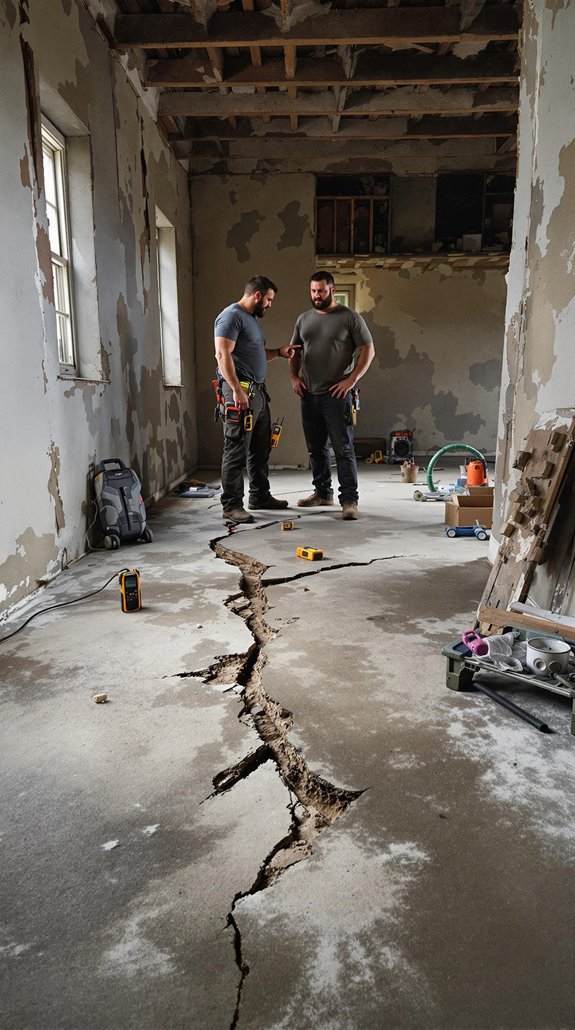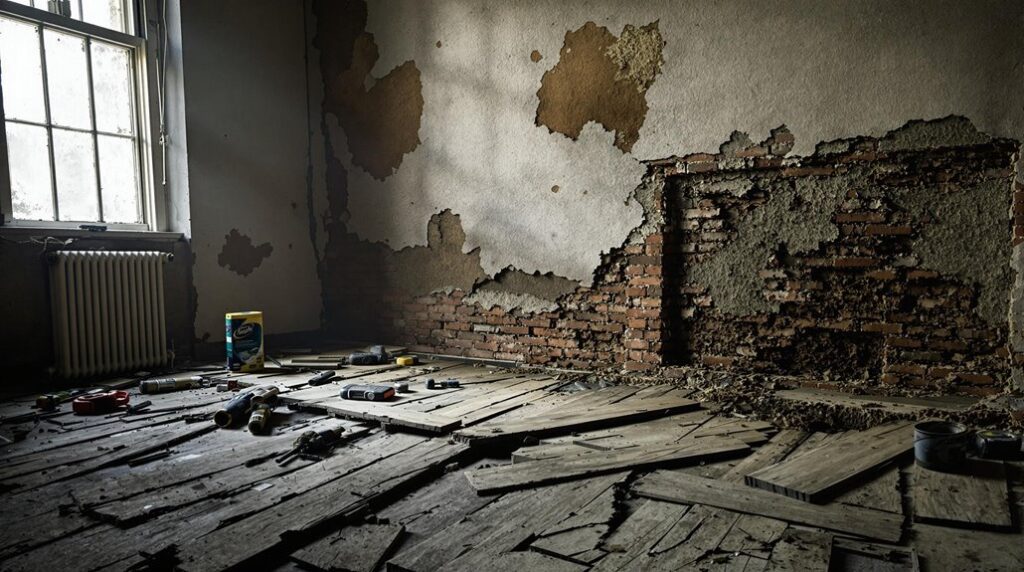I’ve seen countless renovation dreams turn into nightmares when hidden structural problems emerge mid-project. You’ll think you’re simply updating a kitchen or bathroom, then discover major subsidence cracks behind that wall you’ve just opened up. These discoveries don’t just add stress—they can triple your budget and extend timelines by months. The key isn’t avoiding these issues entirely, but knowing how to spot warning signs early and respond strategically when problems surface unexpectedly.
Key Takeaways
- Set aside 20-30% contingency funds and time buffer as nearly half of homeowners face over $5,000 in unexpected repairs.
- Identify subsidence early by checking for diagonal cracks near windows, misaligned doors, and stair-step patterns in exterior masonry.
- Conduct structural surveys before renovation since 30% of remodels uncover foundation issues that can double your budget.
- Establish daily communication protocols with contractors and document all issues with timestamped photos to prevent information gaps.
- Plan for specialized removal of hazardous materials like asbestos or lead, which require professional handling and additional permits.
Common Hidden Problems That Surface During Renovations

While most homeowners enter renovations with carefully planned budgets and timelines, the reality often proves far more complex once demolition begins. I’ve seen 58% of homeowners report projects exceeding expected timelines, and there’s good reason why.
When you open walls, you’re likely to discover electrical issues that’ll cost $1,000-$5,000 in unplanned expenses. Flickering lights and sparking outlets signal deeper problems requiring panel upgrades. Plumbing surprises emerge too—leaky pipes, corrosion, and galvanized materials hidden behind drywall.
Structural problems affect 30% of remodels, including rot and insect damage. You might also encounter hazardous materials like asbestos or lead requiring specialized removal. Additionally, you should be on the lookout for early signs of damp such as musty odors and damp patches, as identifying these issues early protects your investment. The financial impact of these hidden issues is substantial, with 85% of homeowners incurring unplanned repair costs in 2024.
Financial Impact of Structural Discoveries and Budget Planning
When structural issues surface during your renovation, they don’t just add a few hundred dollars to your budget—they can fundamentally reshape your project’s financial landscape. With 30% of home remodels uncovering unexpected structural problems, you’re facing potential cost increases that can double your original budget. The importance of structural surveys cannot be overstated, as they help identify subsidence issues before they escalate.
That $24,000 kitchen renovation becomes considerably more expensive when foundation cracks or outdated wiring emerge. I’ve seen homeowners scramble for additional funding mid-project, forcing difficult decisions about scope and timeline.
Here’s what protects you: hire structural engineers upfront, allocate 20% contingency funds, and work with contractors experienced in structural repairs. Yes, professional assessments cost money initially, but they prevent devastating budget overruns later. Nearly 40% of homeowners who set a budget exceeded it in 2023, with project complications being a common reason for overspending. Address structural issues now—deferred maintenance always costs more.
Timeline Disruptions Caused by Unexpected Repairs

Despite your best planning efforts, unexpected structural repairs can derail your renovation timeline faster than any other factor. I’ve seen handoffs between different trades create the most significant delays—when your electrician discovers damaged wiring that requires structural work before plumbing can proceed, you’re looking at cascading delays.
Material shortages compound these issues. When specialized structural components aren’t readily available, you’ll face extended waiting periods that push everything back. Weather conditions can halt exterior repairs completely, creating bottlenecks that affect interior work sequences. Additionally, investing in proper home insulation can help mitigate the impact of drafts and temperature fluctuations during renovations, leading to a more stable environment for your ongoing work.
The key is building buffer time into your schedule. I recommend adding 20-30% contingency time for unexpected repairs. Consider predictive planning—anticipate potential structural issues during your initial assessment to minimize timeline disruptions and keep your project moving forward efficiently. Skilled labor shortage drives up both project costs and completion timelines, making it essential to secure qualified contractors early in your planning process.
Identifying Subsidence, Damp, and Foundation Issues Early
Recognizing foundation and structural problems before they escalate into major renovation headaches requires a systematic approach to identifying warning signs. I’ll walk you through the key indicators that’ll help you catch subsidence issues early.
Start by examining your walls for vertical or diagonal cracks, particularly near windows and doors. Check if doors stick when opening or windows won’t close properly—these alignment issues often signal foundation movement. Walk through each room looking for sloping or sinking floors, and inspect where skirting boards meet the floor for gaps. Additionally, be mindful of load-bearing walls in your home, as alterations to these structures without proper assessment can aggravate underlying issues.
Don’t overlook separations between walls and ceilings, as these gaps indicate structural shifting. Pay attention to cracks at window and door corners, which are telltale signs of subsidence. Document any new cracks that appear over time, as progressive damage requires immediate professional evaluation.
If you have brick or masonry exteriors, look for distinctive stair-step cracks that follow the mortar joints in a zigzag pattern, as these indicate significant foundation movement.
Working With Contractors When Problems Arise Mid-Project

Once renovation problems surface mid-project, your relationship with contractors becomes the determining factor in whether issues get resolved efficiently or spiral into costly disputes. I’ve learned that establishing clear communication protocols immediately prevents information gaps that lead to frustration. You’ll want to implement daily briefings using shared logs like Buildertrend, ensuring real-time updates flow between both parties. Additionally, understanding the typical renovation costs can help frame discussions about budget adjustments when unexpected issues arise.
When problems arise, I recommend initiating joint on-site assessments within 48 hours. This collaborative approach helps develop solutions using objective criteria rather than emotions. Document everything with timestamped photos and maintain a dedicated change order log with signed approvals.
If direct resolution fails, don’t let issues fester. Engage mediators within seven days and review contract clauses before negotiations escalate further. Designate a single point of contact from your team to streamline all contractor communications and avoid mixed messages.
Prevention Strategies and Emergency Preparedness for Future Projects
While 83% of homeowners encountered unexpected repairs in 2024—nearly double the previous year’s rate—the most successful renovators share one common trait: they’ve developed thorough prevention strategies and emergency preparedness plans before breaking ground.
I’ve seen how 29% of homeowners now prioritize emergency planning, with 47% creating or updating plans for 2025. Your emergency strategy should address the most common issues: water damage, roof problems, and door/window malfunctions. Don’t skip permits to speed things up—35% consider this shortcut, but it creates bigger problems later. Additionally, understanding planning permissions is crucial to avoid complications during the renovation process.
Set aside contingency funds since 46% spent over $5,000 on unexpected repairs. Include regulatory timelines in your planning, as 33% face month-long permit delays. Remember, 34% need a month or more to settle back in post-renovation, so plan your recovery phase too.
Project managers splitting time between multiple sites often leave homeowners without proper guidance when unexpected issues arise, making immediate decision-making more difficult during critical moments.
Conclusion
I’ve learned that unexpected renovation problems aren’t just inconveniences—they’re expensive reality checks that’ll derail your project if you’re unprepared. You can’t prevent every surprise, but you can minimize their impact through thorough pre-renovation surveys, maintaining 20-30% budget contingencies, and establishing clear communication protocols with contractors. Don’t skip the structural assessment—it’s cheaper than discovering subsidence mid-renovation. Stay proactive, document everything, and you’ll navigate these challenges without losing your sanity or savings.
References
- https://listwithclever.com/research/home-renovation-trends/
- https://www.lamontbros.com/learning-center/top-3-most-common-remodeling-problems-how-to-avoid-them
- https://www.carriermanagement.com/news/2025/01/10/270404.htm
- https://www.loadbearingwall.com/unexpected-renovation-expenses-the-complete-guide/
- https://www.gallerykbny.com/post/home-remodeling-myths-and-facts-general-contractors-tell-all
- https://www.nextstagedesign.com/home-remodeling-costs/
- https://www.nar.realtor/magazine/real-estate-news/most-common-inspection-problems-uncovered-in-new-homes
- https://murraylampert.com/beware-these-10-hidden-costs-during-your-home-remodel/
- https://www.kaminskiyhomeremodeling.com/blog/uncovering-structural-issues-in-remodel/
- https://www.southalabama.edu/colleges/mcob/news/home-renovation-statistics.html

